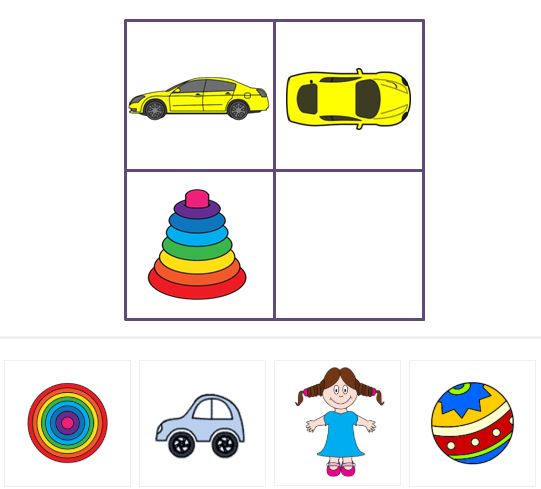Is your child a visual learner? S/he might enjoy solving questions in the Pictorial Reasoning section of the OLSAT. Continue reading to get a better understanding of these questions.
One of the subtests in the OLSAT Nonverbal section is Pictorial Reasoning. This section assesses the ability to reason using pictures and visual items. Specifically, it tests the ability to:
- Understand and deduce relationships between objects
- Understand similarities and differences
- Deduce patterns and progressions
Since these questions are part of the Nonverbal section, directions are not provided. Rather, all of the information is obtained from the images themselves.
Pictorial Reasoning Question Types
The Pictorial Reasoning category has three question types: Picture Classification, Picture Analogies, and Picture Series. These questions assess a child's ability to reason with different pictures and illustrations, find relationships, similarities and differences among objects, and be able to understand and continue progressions.
| Type | Level | Description |
|---|---|---|
| Picture Classification | A-C | These questions measure the ability to identify the “odd one out.” Given five pictures, a child will have to identify which image does not belong in the group by recognizing a common theme or pattern present throughout the images. |
| Picture Analogy | A-C | These questions also test the ability to understand relationships between pictures. The objective is to identify which picture from a group of five is most similar to the original picture presented in the question. While Picture Classification items assess the ability to identify differences, Picture Analogy items assess the ability to identify similarities. |
| Picture Series | A | These questions assess the ability to understand patterns and progressions. Given a progression of images, a child will have to be able to identify a pattern and predict what picture comes next in the series. |
Pictorial Reasoning Sample Question
The following question is a Picture Analogy test item from the Pictorial Reasoning section:

The pictures in the boxes on the top belong together in a certain way. Choose the picture that belongs with the bottom picture in the same way the pictures on top belong together.
Answer and Explanation
The correct answer is A.
A car viewed from the side is to a car viewed from a bird's eye view as a stack of rings viewed from the side is to a stack of rings viewed from a bird's eyes view.
How to Prepare for the OLSAT
It is important that you prepare your child by first introducing him/her to the OLSAT, and familiarizing him/her with the format and content of the test. Ensuring that your child puts in the time to practice for the OLSAT is a very important factor in your child's success. However, figuring out exactly what and how to study for the OLSAT can be difficult, and with competition for spots in gifted programs at an all-time high, it is extremely important to be well-prepared for test day. At TestPrep-Online, we provide age-specific, tailor-made study packs with realistic practice tests, practice questions and study guides to ensure that your child is prepared for the OLSAT.
Remember that questions of the types seen on the OLSAT test are not practiced at school. Therefore, your child will probably not be familiar with them. For this reason, it is highly recommended to practice beforehand, as familiarity with the question types and obtaining tools for different types is very helpful and will reflect your child's abilities more accurately. Therefore, make sure your child solves all the questions on the practice pack we offer. If your child needs extra practice on non-verbal questions, it is recommended to purchase an OLSAT & NNAT bundle pack. The NNAT, like the OLSAT, is a test used by numerous schools throughout the country as an admission test to their gifted and talented programs, and it consists of non-verbal questions only that are similar to those on the OLSAT. Purchasing the bundle pack, therefore, can give your child the extra practice he or she needs and allow him or her to reach their full potential.
Our practice packs include step-by-step explanations for all the questions on the pack. It is highly recommended to read the explanations. Encourage your child to try each question several times before giving up, but read the explanation nonetheless, even if he or she answered the question correctly. The explanation provides extra details and tools that might be useful for future, more difficult questions of the same type, so reading it is a good study habit.
No matter how old your child is, remember positive feedback always works better than negative feedback. Praise your child whenever he or she works correctly and follows the study plan you built together.
OLSAT Question Types
See the table below for a breakdown of the OLSAT question types and subsections.
| Verbal | Nonverbal |
|---|---|
| Verbal Comprehension | Pictorial Reasoning |
| Following Directions | Picture Classification |
| Antonyms | Picture Analogies |
| Sentence Completion | Picture Series |
| Sentence Arrangement | Figural Reasoning |
| Verbal Reasoning | Figural Classification |
| Aural Reasoning | Figural Analogies |
| Arithmetic Reasoning | Pattern Matrix |
| Logical Selection | Figural Series |
| Word/Letter Matrix | Quantitative Reasoning |
| Verbal Analogies | Number Series |
| Verbal Classification | Numeric Inference |
| Inference | Number Matrix |



